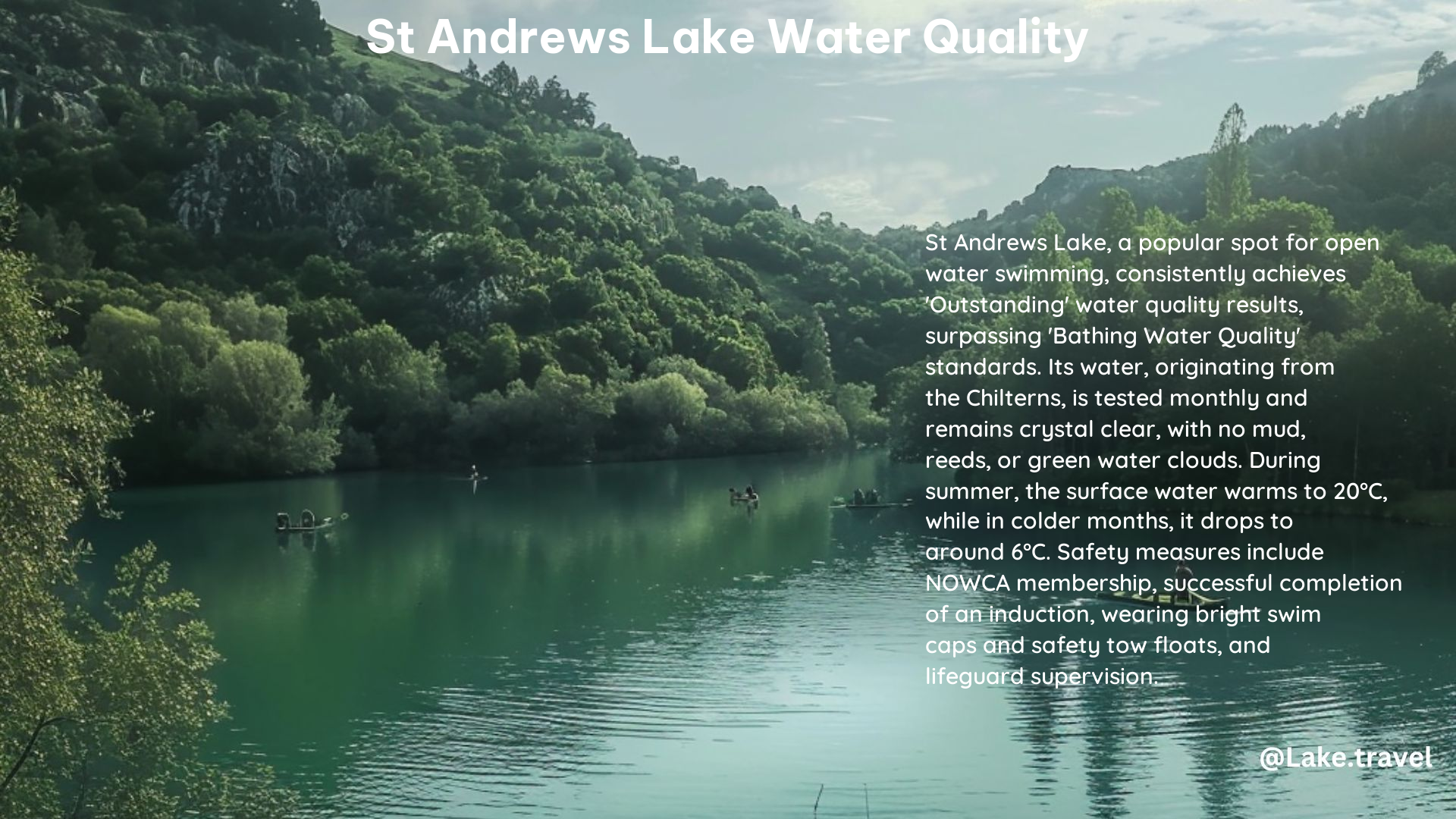St Andrews Lakes, located in Halling, offers a unique open water swimming experience with its crystal clear waters, originating from the Chilterns. The water is tested monthly and consistently returns an ‘Outstanding’ result, significantly above ‘Bathing Water Quality’ standards. It is noteworthy for its beautiful turquoise color and high water quality, which is free from mud, reeds, and green water clouds.
Exceptional Water Quality at St Andrews Lakes
The water quality at St Andrews Lakes is exceptional, with the lake consistently receiving an ‘Outstanding’ rating from water quality tests. This means the water is of the highest purity, free from contaminants and pollutants that could pose a risk to swimmers.
Monthly Water Quality Testing
The water at St Andrews Lakes is tested monthly by the relevant authorities to ensure it meets the highest standards for open water swimming. These tests examine a range of parameters, including:
- Bacterial levels (E. coli and intestinal enterococci)
- pH levels
- Turbidity (water clarity)
- Presence of algae and other contaminants
The results of these tests are made publicly available, allowing swimmers to have confidence in the water quality and safety of the lake.
Bathing Water Quality Standards
In addition to the ‘Outstanding’ rating, St Andrews Lakes also meets the strict ‘Bathing Water Quality’ standards set by regulatory bodies. These standards are designed to ensure the water is safe for recreational use, with limits on the levels of bacteria and other pollutants.
The fact that St Andrews Lakes consistently exceeds these standards is a testament to the exceptional care and management of the water quality at the site.
Seasonal Water Temperature Variations

The water temperature at St Andrews Lakes varies throughout the year, with the surface water warming up to 20°C during the summer months. This makes the lake an attractive option for swimmers who prefer a more natural, open-air experience compared to indoor pools.
Summer Swimming Conditions
During the warmer months, the lake surface water can reach a comfortable 20°C, allowing swimmers to enjoy the fresh air and beautiful surroundings while still experiencing a refreshing swim.
Colder Weather Adaptations
When the water temperature drops below 10°C during the colder months, the swimming course is reduced to 200m for increased safety. This ensures that swimmers can continue to enjoy the lake while minimizing the risks associated with prolonged exposure to cold water.
Swimmer Safety and Regulations
Swimmer safety is a top priority at St Andrews Lakes, with a range of measures in place to ensure a safe and enjoyable experience for all visitors.
Mandatory NOWCA Membership and Safety Gear
All swimmers at St Andrews Lakes are required to be members of the National Open Water Coaching Association (NOWCA). This ensures that they have the necessary knowledge and skills to swim safely in open water environments.
In addition, swimmers must wear brightly colored swim caps and use safety tow floats while in the water. These measures help to improve visibility and allow the swim staff to monitor the swimmers’ locations.
Mandatory Inductions and Swim Staff Supervision
Before booking a swim session, all swimmers must undergo a mandatory induction with the swim staff. This induction covers the site layout, safety procedures, and any other relevant information to ensure that swimmers feel safe and familiar with the environment.
During swim sessions, the staff are on hand to provide supervision and assistance to swimmers as needed, further enhancing the safety of the experience.
Potential Water Quality Fluctuations
While the water quality at St Andrews Lakes is generally excellent, it is important to be aware of potential fluctuations, particularly during or after heavy rainfall.
Agricultural Run-off and Combined Sewer Overflows
According to SEPA’s water quality profiles for St Andrews (West Sands) and St Andrews (East Sands), the main risks to water quality are wet weather-driven short-term pollution, primarily from agricultural run-off and combined sewer overflows.
Bathing Advisories During Heavy Rainfall
Due to the increased risk of water pollution during and after heavy rainfall, bathing is not advised at St Andrews Lakes during these periods. The swim staff and relevant authorities closely monitor the water quality and provide updates to ensure the safety of swimmers.
Water Quality Monitoring in Other Regions
While the focus of this article has been on the exceptional water quality at St Andrews Lakes, it’s worth noting that water quality monitoring and preservation efforts are ongoing in other regions as well.
St. Andrews Aquatic Preserve and Saint Andrews Lake in Florida
In Florida, the St. Andrews Aquatic Preserve and Saint Andrews Lake also monitor nutrients and water clarity through partnerships with the DEP’s Division of Environmental Assessment. These efforts help to ensure the long-term health and sustainability of these important water bodies.
By understanding the water quality at St Andrews Lakes and the measures in place to maintain it, swimmers can enjoy a safe and rewarding open water swimming experience in a truly stunning natural setting.
References:
– St Andrews Watersports – Open Water Swimming
– SEPA – St Andrews West Sands Bathing Water Profile
– Florida DEP – St. Andrews Aquatic Preserve Water Quality
– Polk Water Atlas – Saint Andrews Lake
– SEPA – St Andrews East Sands Bathing Water Profile
